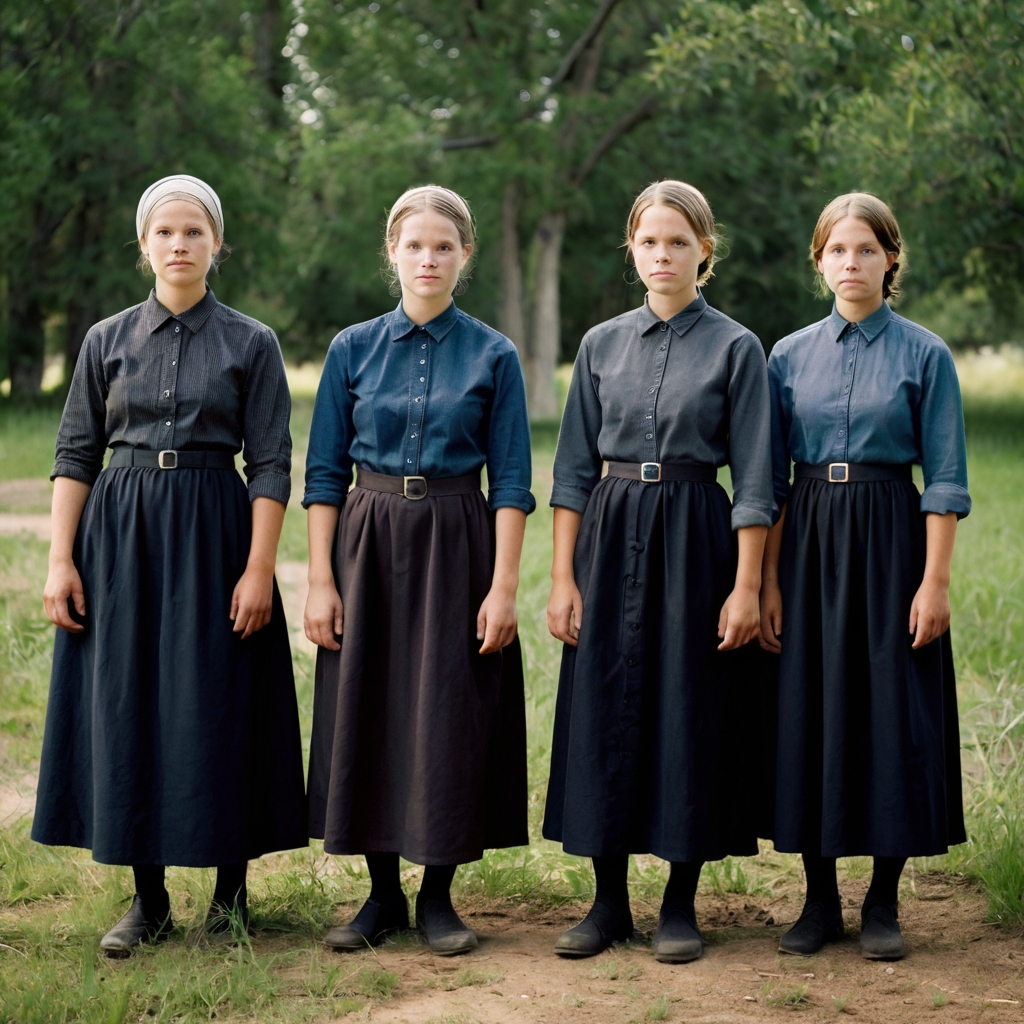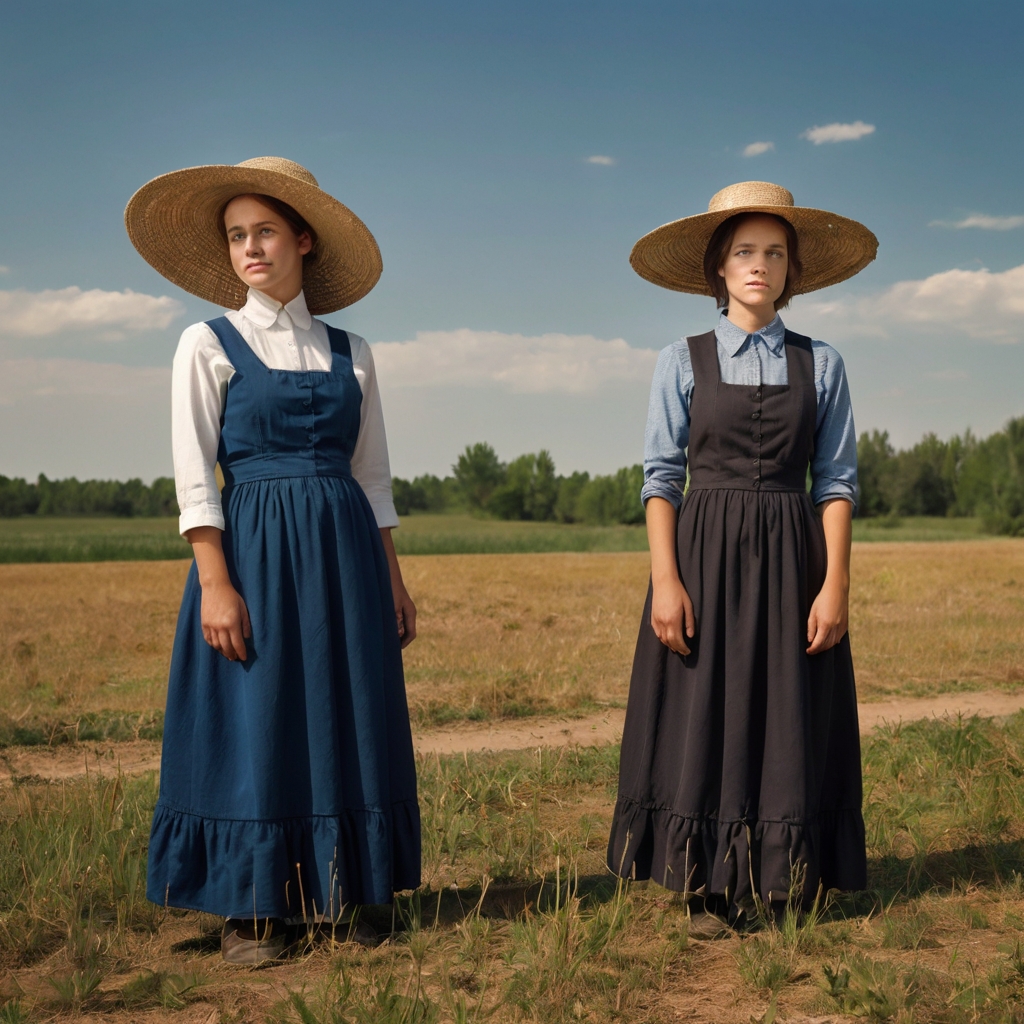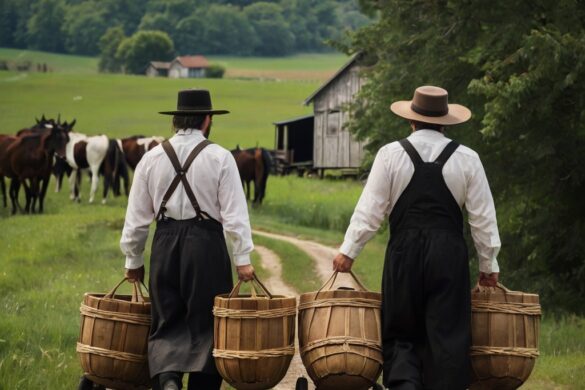People often mix up Mennonite, Amish, and Quaker communities, but these religious groups have their own unique traditions. Mennonites make up the largest group with 2 million members worldwide. The Amish community has 360,000 members mostly in North America. Quakers number around 370,000 globally, and almost half of them live in Africa.
These groups have some shared history, but they started differently and follow different practices. The Amish and Mennonites came from the Anabaptist movements in southern Germany, France, and Switzerland back in the 1500s and 1600s. Quakers emerged later during England’s Civil War. The biggest difference between Amish and Mennonite groups shows up in how they deal with modern life. The Amish stay away from technology and stick to horse-drawn buggies and plain clothes. Most Mennonites have accepted modern conveniences like cars, electricity, and cell phones.
Their religious practices set them apart too. Quakers have a unique way of worship without any priests or pastors. Mennonites’ values have shaped their actions throughout history. The sort of thing I love is how they stood up for their beliefs – more than 40 percent of all conscientious objectors in World War II were Mennonite. This piece will take a closer look at these differences, from their beliefs to their clothing choices that make each of these misunderstood religious groups special.

The Origins of Amish, Mennonites, and Quakers
These religious communities have deep roots that trace back to crucial moments in European religious history. Bold reformers challenged church practices and paid heavy prices for their beliefs.
How the Anabaptist movement shaped Amish and Mennonites
The Anabaptist movement started in 1525 Zurich, Switzerland. Conrad Grebel, George Blaurock, and others began rebaptizing adults who had received baptism as infants. Their radical decision to give adults a second baptism after they consciously chose to follow Christ earned them the name “Anabaptists” or “rebaptizers”. These early Anabaptists took Jesus’ teachings literally, especially the Sermon on the Mount, and became some of the first people to support separation of church and state.
Their revolutionary ideas led to brutal persecution. Nearly 2,500 Anabaptists lost their lives in the movement’s first century – burned at stake, drowned in rivers, or beheaded. Many fled to rural areas and went into hiding.
The Mennonites got their name from Dutch leader Menno Simons who joined in 1530, but they actually started with Swiss Anabaptists. A major split happened in 1693 when Jakob Ammann, a Swiss Anabaptist leader, pushed for stricter rules. He wanted to shun excommunicated members, add foot washing to worship, and make everyone wear uniform dress with untrimmed beards. His followers became the Amish after attempts to reconcile failed.
The Quaker emergence during the English Civil War
Quakerism developed differently almost a century later. The movement began in England right after the English Civil War (mid-17th century), during a time of radical religious and political change.
George Fox started Quakerism after becoming disappointed with the established church. He and early Quakers taught revolutionary ideas – mainly that people could hear God’s voice directly through “inner light” without needing priests or even the Bible.
Early Quakers believed “there is that of God in everyone” and rejected churches, rituals, holy days, and sacraments. They met without leaders and sat quietly until someone felt moved to speak. These beliefs worried authorities who thought Quakers might disrupt social order.
Why these groups came to America
Constant persecution forced Anabaptists to cross the Atlantic. They moved from one European region to another because they refused to join military service and put God above government.
William Penn, an English Quaker who knew persecution firsthand, offered hope by inviting European religious minorities to his new colony. King Charles II gave Penn a large piece of land in the 1680s where he guaranteed complete religious freedom – a revolutionary idea back then.
The first Mennonites reached Philadelphia in October 1683 and built a permanent settlement in future Germantown. Amish groups started moving to Pennsylvania in the 1820s, seeing Penn’s colony as an answer to their prayers for religious freedom. Today, no Amish communities exist in Europe.
This migration pattern explains why Lancaster County, Pennsylvania now has both the world’s largest Mennonite community and second-largest Amish population – evidence of how religious freedom helped shape America’s cultural map.
Core Beliefs and Religious Practices
Religious foundations of Mennonite, Amish, and Quaker faiths show deep differences in their relationship with God. Visitors to these communities quickly find that distinct theological worlds exist beneath their seemingly similar “plain” exteriors.
Adult baptism vs spiritual inner light
The life-blood difference among Mennonite, Amish and Quaker beliefs lies in how people join their faith. Amish and Mennonites, as Anabaptists, place supreme importance on adult baptism. Young people usually take their baptismal vows between ages 18 and 22 after several weeks of instruction. This decision marks the crucial moment in Amish youth’s life – a lifelong promise to God and community that establishes their church accountability forever.
Baptism symbolizes repentance from sin and steadfast dedication to Christ for both Amish and Mennonites. They reject infant baptism because children cannot make conscious spiritual commitments. Both groups see baptism as purely symbolic, offering no automatic spiritual benefit.
Quakers take an entirely different spiritual path. They practice “the inner light” that expresses following one’s conscience and intuition instead of external rituals. Quakers don’t practice baptism at all. They believe everyone can have a direct relationship with God without ceremonies. Their core belief that “there is that of God in everyone” drives this fundamental difference.
Church services: structured vs silent worship
Service attendance reveals stark contrasts in Mennonite, Amish and Quaker worship styles. Amish services happen every other Sunday (26 times yearly) and last about eight hours. Members gather in homes or barns rather than dedicated church buildings.
Amish service’s benches arrange in two sections—men facing women. Ministers deliver sermons in Pennsylvania Dutch while standing level with congregants. Hymns and scripture readings occur in old German. This whole ordeal emphasizes humility, patience, and silence.
Quaker worship runs with remarkable simplicity. Most Quakers follow “unprogrammed” worship—silent gatherings without sermons, music, or liturgical elements. Members sit in a circle and wait for spiritual insight. People stand and share their message with others when they feel spiritually moved. Quaker meeting houses have no religious symbols, altars, or hierarchical seating.
Views on sacraments and clergy
Sacramental approaches further set these faith traditions apart. Amish observe communion twice yearly—spring and fall—during special eight-hour services. Members undergo spiritual life examination before participating. Communion includes bread, wine, and the unique practice of foot-washing where members wash each other’s feet while singing.
Mennonites also reject the notion that sacraments automatically give spiritual benefits. Both Amish and Mennonites baptize by sprinkling or pouring water rather than immersion.
Quakers stand alone by rejecting all sacraments. They neither baptize members nor celebrate communion because they see all moments as equally sacred.
Leadership differs too. Amish and Mennonites believe “true gospel ministry is not the result of theological education, but a gift bestowed by God”. They historically opposed paid ministry. Quakers take this idea further and generally function without ministers or church hierarchy. Their theological tolerance lets each person’s experience of God guide their faith.
These core differences in belief and practice shape how Mennonite, Amish and Quaker communities live their faith experiences, despite sharing values of simplicity and peace.
Lifestyle and Community Differences
The belief systems of Mennonite, Amish, and Quaker communities shape their daily lives. These groups have unique ways of adapting to modern living that become apparent when you spend time with them.
Technology use: from buggies to smartphones
The Amish have a selective approach to technology rather than rejecting it completely. They don’t allow personal cars, public electricity, TVs, or home internet. They do use battery-powered tools, pneumatic equipment, and solar panels. Their iconic buggies serve local travel needs under 20 miles, though they’ll ride as passengers in cars for longer trips.
The Amish continue to demonstrate their creativity within traditional boundaries. Their modern buggies now feature fiberglass bodies, specially treated wood, and lighting systems powered by cordless tool batteries.
Most Mennonites accept modern technology such as electricity, cars, and appliances. Their lifestyle looks much like mainstream society on the surface, though they hold onto their core values of simplicity.
Quakers have merged with the technological world. They use computers, smartphones, and modern conveniences without restriction.
Education and work life
These communities take different paths when it comes to education. Amish children finish school after 8th grade at age 13-14, thanks to a 1972 Supreme Court ruling that granted them religious exemption. Their students learn practical skills, reading, writing, arithmetic, and Amish history.
Mennonites take a different approach by supporting higher education through their own colleges and universities. This focus on education helps explain why many Mennonites have moved beyond farming into various professional careers.
Quaker “Friends schools” place equal importance on spiritual growth and academic achievement.
Economic changes have led many Amish people to become entrepreneurs instead of farmers. Their businesses succeed more often than mainstream ones, with a failure rate below 10%. Mennonites have also adapted – only 7% still work in agriculture.
Marriage, family, and community roles
Amish households maintain traditional gender roles. Husbands earn the living while wives take care of the home and children. Each couple’s dynamic varies, but husbands lead the family’s religious life.
Mennonite families have become more equal in their roles. Most married women now work full-time outside their homes. Family sizes tell another story – Amish families typically have 6-8 children, while Mennonite families average 2.3 children.
Marriage remains central to both communities. Mennonites marry at high rates – 91% of women and 98% of men. They divorce less often, with rates at less than half the national average.
These three groups maintain strong community bonds, though each balances tradition and modern life in its own way.
Clothing and Appearance Explained
Religious communities like the Amish, Mennonites, and Quakers stand out through their unique clothing choices. Their distinctive dress styles tell a rich story about their beliefs and their relationship with modern society.
Mennonite vs Amish vs Quaker clothing styles
Amish people stick to a plain dress code that barely changed through the years. The men wear dark suits, plain shirts, and broad-brimmed hats. They grow beards after marriage but keep their upper lips clean-shaven. Women’s outfits consist of long, solid-colored dresses with capes or aprons and special prayer coverings or bonnets. They use straight pins or hooks and eyes to fasten clothes because buttons seem too decorative to them.
Mennonite clothing styles vary substantially between different congregations. Old Order Mennonites dress much like the Amish, but many groups allow brighter fabrics and looser standards. The women’s head coverings are usually smaller than Amish bonnets. Many modern Mennonite groups have moved away from traditional coverings.
Today’s Quakers blend right in with mainstream fashion. A small number of conservative Quakers still prefer plain dress. Back in the day, Quakers stayed away from “ruffles and lace and other forms of ornamentation, as well as unnecessary cuffs and collars”.
Symbolism behind plain dress
Plain clothing symbolizes a clear break from worldly influences. Quaker minister Elizabeth Fry described the Amish dress as “a hedge against the world”. Head coverings carry special meaning – Anabaptist women wear them to show their submission to God and their husbands.
How clothing reflects values
Each group’s clothing choices mirror their fundamental beliefs. The Amish wear uniform styles to put community before individual expression, which helps prevent feelings like envy and jealousy. Mennonite dress shows how they balance tradition with practical modern life. Traditional Quakers used clothing to express their commitment to simplicity – George Fox urged them to “keep out of the vain fashions of the world”.
These three traditions use clothing as a daily reminder of their faith and shared heritage.
Modern-Day Presence and Global Reach
These three faith traditions have established unique communities and followings worldwide. My visits to their communities revealed remarkable differences in how each group directs its path through modern society.
Population and where they live today
Mennonites stand as the largest community with 2.13 million members worldwide. They live in 87 countries on six continents. The United States leads with 500,469 members, followed by Ethiopia (310,912) and the Democratic Republic of Congo (225,581). The Mennonite World Conference now has 109 member denominations spread through 59 countries.
The Amish community has grown to 411,060 people by 2025. Their numbers have more than doubled from 177,910 since 2000. Amish settlements now exist in 32 U.S. states and three Canadian provinces. Ohio, Pennsylvania, and Indiana house 61% of the population. Large families with an average of 5+ children and an impressive 85% retention rate fuel this rapid growth.
Quakers remain the smallest of these groups with about 360,000 adult members globally.
How each group interacts with the outside world
Amish people choose carefully when to connect with mainstream society. They sell handcrafted goods at farmers’ markets, build relationships with non-Amish neighbors, and seek medical care when needed. Yet they set clear boundaries by sending their children to Amish-only schools and churches.
Most moderate Mennonites show greater openness to the wider world. They take part in general society as “salt and light” and use modern technologies freely. Philadelphia shows this integration well – by 2000, the city had 17 Mennonite congregations that worshiped in eleven different languages.
Quakers blend seamlessly into society and have earned recognition for their excellent educational institutions.
Cultural influence and public perception
These groups have left lasting marks on American history. Quakers earned respect for their early opposition to slavery. The Amish have become cultural icons, representing simplicity in our complex world through their steadfast resistance to modernization.
Summing all up
These three faith traditions share historical roots and values like simplicity and pacifism. Yet each community’s unique approach to faith and daily life makes them fascinating to explore. The Amish community stands out with their careful choices about modern technology, their iconic horse-drawn buggies, and their steadfast dedication to traditional ways of life. Mennonites show remarkable flexibility – they keep their core spiritual values alive while embracing today’s conveniences and education. Quakers take a different path from both groups. They focus on direct spiritual connection instead of rituals, adopt progressive social views, and fully participate in modern society.
You can see these differences clearly when visiting their communities. Lancaster County visitors might spot Amish families wearing traditional clothes and traveling by buggy, right next to Mennonites who drive cars and use smartphones. On top of that, these groups have grown beyond their original American settlements. Mennonite communities now thrive across six continents, and Quakers have built strong presences in Africa.
Their impact on culture goes way beyond their small numbers. The Amish keep traditional craftsmanship and farming methods alive that might have disappeared. Mennonites have created respected schools and relief organizations that serve people worldwide. Quakers, despite being few, helped shape America’s core values through their early fight against slavery and push for equality.
The sort of thing I love about these communities is how they offer different viewpoints on dealing with our complex world. Their approaches couldn’t be more different – from the Amish’s selective technology use to Quakers’ full embrace of modern life. Yet all three groups show us how to build meaningful communities around deep spiritual values.
Of course, knowing these differences helps clear up common mix-ups about these religious groups. People encounter them through tourism, historical research, or personal connections. Either way, Mennonite, Amish, and Quaker communities continue to show us powerful examples of humanity’s search for meaning, community, and purpose.
Here are some FAQs about mennonite vs amish vs quaker:
Are Quakers the same as Mennonites?
While both are peace churches, the mennonite vs amish vs quaker comparison shows significant theological differences. Quakers vs amish vs mennonite traditions vary greatly in worship styles and community structures. The amish vs mennonite vs quaker distinction is evident in their approaches to scripture, with Quakers emphasizing inner light over biblical literalism.
Why are they called Quakers?
The name originated from critics mocking how Quakers vs amish vs mennonite believers would tremble during spiritual experiences. Unlike the mennonite vs quaker vs amish naming conventions, “Quaker” began as a derogatory term they later embraced. This differs from amish vs mennonite vs quaker naming origins, as Amish and Mennonite derive from their founders’ names.
Do Quakers dress like Amish?
The mennonite vs amish vs quaker clothing comparison shows Quakers historically dressed plainly but don’t maintain distinctive dress today. While amish vs mennonite vs quaker clothing traditions all emphasized modesty, only Amish and conservative Mennonites retain traditional garb. Quaker vs amish vs mennonite attire demonstrates Quakers’ adaptation to mainstream fashion over time.
What is the difference between Mennonite and Hutterite?
When comparing mennonite vs amish vs quaker groups, Hutterites share more communal living with Amish than Mennonites do. The amish vs mennonite vs quaker spectrum places Hutterites closer to Amish in isolationism, though all three differ theologically. Quaker vs amish vs mennonite practices show Hutterites are distinct in maintaining communal property like early Christians.
What is the closest religion to Mennonites?
In the mennonite vs amish vs quaker family tree, Amish are closest as they originated from Mennonite schisms. The quaker vs amish vs mennonite comparison shows Amish share more theological similarities with Mennonites than Quakers do. Among amish vs mennonite vs quaker groups, Hutterites and Brethren also share Anabaptist roots with Mennonites.
Do Quakers believe in Jesus?
While exploring mennonite vs quaker vs amish beliefs, all three groups are Christian but interpret Christ’s teachings differently. The quaker vs amish vs mennonite comparison shows Quakers emphasize Christ’s inner light over doctrinal specifics. Unlike amish vs mennonite vs quaker biblical literalism, Quakers focus more on personal spiritual experience of Christ.
Why were the Quakers so hated?
Historical persecution of Quakers vs amish vs mennonite groups stemmed from different reasons for each. The mennonite vs amish vs quaker experience shows Quakers faced opposition for rejecting social hierarchies and challenging state churches. While amish vs mennonite vs quaker groups all faced persecution, Quakers’ radical egalitarianism particularly threatened established power structures.









